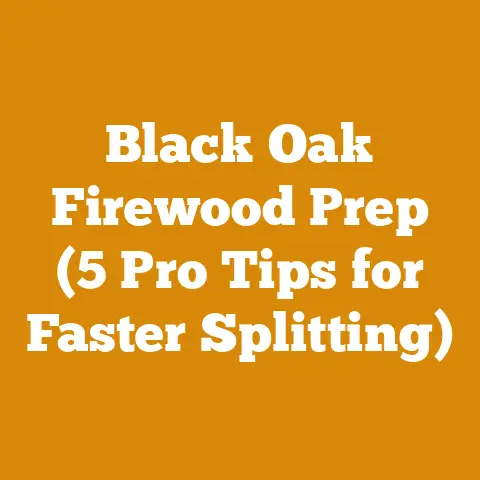Hot Wood Firewood Guide (Top 15 BTU Ratings Explained)
Unlock the Inferno: Your Ultimate Guide to Firewood BTU Ratings and the Hottest Burning Woods
Have you ever sat beside a crackling fire, feeling its warmth seep into your bones, and wondered what makes some wood burn hotter and longer than others? I have. For years, I’ve been obsessed with the science and art of firewood, from felling the trees to splitting the logs and ultimately, enjoying the fruits (or rather, the heat) of my labor. I’ve learned firsthand that not all firewood is created equal. Some species are like damp squibs, barely offering a flicker, while others roar with intense heat, turning your fireplace into a personal sun.
Key Takeaways You’ll Discover:
- What BTU Ratings Mean: A clear, concise explanation of what BTUs are and why they matter when choosing firewood.
- The Top 15 Hottest Burning Woods: A detailed breakdown of the best wood species, ranked by BTU, with their pros, cons, and ideal uses.
- Factors Beyond BTU: Exploring other critical factors like seasoning, moisture content, and wood density that influence burn quality.
- Choosing the Right Firewood for You: Practical advice on selecting the best firewood based on your specific needs, budget, and location.
- Safe Firewood Practices: Essential tips for storing, handling, and burning firewood safely and efficiently.
So, grab a cup of something warm, settle in, and let’s get fired up about firewood!
What is a BTU and Why Does It Matter for Firewood?
Let’s start with the basics: BTU stands for British Thermal Unit. It’s a unit of measurement that quantifies the amount of energy required to raise the temperature of one pound of water by one degree Fahrenheit. In the context of firewood, the BTU rating tells us how much heat a specific type of wood will produce when burned.
Think of it like this: a higher BTU rating means more heat per log. A wood with a high BTU rating will generally burn hotter, longer, and more efficiently than a wood with a lower rating. This translates to fewer trips to the woodpile, more consistent warmth, and potentially lower overall firewood costs.
Why BTU Matters:
- Heating Efficiency: Higher BTU wood provides more heat for the same volume of wood, making it more efficient for heating your home.
- Cost Savings: While high-BTU wood might be more expensive per cord, it can save you money in the long run by requiring less wood to achieve the desired warmth.
- Burn Time: High-BTU woods tend to burn longer, reducing the need to constantly feed the fire.
- Creosote Reduction: Drier, high-BTU wood burns cleaner, reducing the buildup of creosote in your chimney, which is a fire hazard.
Data Point: A study by the U.S. Department of Agriculture found that homes heated primarily with wood can save up to 30% on heating costs compared to homes using propane or oil, especially when using high-BTU, well-seasoned firewood.
The Top 15 Hottest Burning Firewoods: A BTU Breakdown
Alright, let’s get to the heart of the matter: the top 15 wood species known for their high BTU ratings and exceptional burning characteristics. Remember, these are average values, and actual BTU output can vary based on factors like moisture content and tree age.
Important Note: BTU ratings are typically expressed per cord (128 cubic feet) of seasoned wood.
-
Osage Orange (32.9 million BTU/cord): This is the undisputed king of firewood. Osage Orange is incredibly dense and burns with intense heat, making it ideal for extremely cold climates. It’s known for its long-lasting coals and minimal smoke.
- Pros: Highest BTU, long-lasting coals, minimal smoke.
- Cons: Very difficult to split, can spark excessively, relatively rare.
- Ideal Use: Primary heating in extremely cold climates, long overnight burns.
-
Hickory (Various Species, 27.7 million BTU/cord average): Hickory, particularly Shagbark and Pignut Hickory, is a powerhouse. It burns hot and clean, producing a pleasant aroma. It’s also a favorite for smoking meats.
- Pros: High BTU, burns clean, excellent aroma, good for smoking.
- Cons: Can be difficult to split, requires long seasoning time.
- Ideal Use: Heating, cooking, smoking meats.
-
Ironwood/Hornbeam (27.2 million BTU/cord): Ironwood lives up to its name. This incredibly dense wood burns hot and long, producing excellent coals. It’s known for being difficult to split.
- Pros: High BTU, long burn time, excellent coals.
- Cons: Very difficult to split, can be slow to ignite.
- Ideal Use: Heating, long overnight burns.
-
Beech (27 million BTU/cord): Beech is a reliable and consistent firewood choice. It burns hot and clean, with a steady flame and good coaling properties.
- Pros: High BTU, burns clean, steady flame, good coals.
- Cons: Can be susceptible to rot if not seasoned properly.
- Ideal Use: General heating, fireplaces.
-
Black Locust (26.8 million BTU/cord): Black Locust is naturally rot-resistant, making it an excellent choice for outdoor storage. It burns hot and clean, with minimal smoke.
- Pros: High BTU, rot-resistant, burns clean, minimal smoke.
- Cons: Can be difficult to split, thorns on branches.
- Ideal Use: Outdoor heating, stoves, fireplaces.
-
Oak (Various Species, 24-26 million BTU/cord average): Oak is a classic firewood choice, and for good reason. It burns hot and long, producing excellent coals. Red Oak tends to be slightly lower in BTU than White Oak.
- Pros: High BTU, long burn time, excellent coals, readily available.
- Cons: Requires long seasoning time, can be difficult to split (especially Red Oak).
- Ideal Use: General heating, stoves, fireplaces.
-
Sugar Maple (24 million BTU/cord): Sugar Maple is a dense hardwood that burns hot and clean, with a pleasant aroma. It’s a favorite for heating and cooking.
- Pros: High BTU, burns clean, pleasant aroma, good for cooking.
- Cons: Can be moderately difficult to split.
- Ideal Use: Heating, cooking, fireplaces.
-
Birch (Yellow Birch, 20.2 million BTU/cord): Yellow Birch offers a good balance of heat, ease of splitting, and pleasant aroma. It burns relatively clean and produces decent coals.
- Pros: Good BTU, relatively easy to split, pleasant aroma.
- Cons: Doesn’t burn as long as oak or hickory.
- Ideal Use: General heating, fireplaces, campfires.
-
Ash (White Ash, 23.6 million BTU/cord): Ash is known for being easy to split and burning relatively clean. It provides good heat and doesn’t require as long of a seasoning time as oak.
- Pros: Good BTU, easy to split, burns relatively clean.
- Cons: Doesn’t burn as long as oak or hickory. Emerald Ash Borer infestations are a major concern.
- Ideal Use: General heating, stoves, fireplaces.
-
Cherry (Black Cherry, 20 million BTU/cord): Cherry is prized for its sweet aroma and attractive flame. It burns relatively hot and is easy to split.
- Pros: Good BTU, easy to split, sweet aroma, attractive flame.
- Cons: Doesn’t burn as long as oak or hickory, can be prone to sparking.
- Ideal Use: Fireplaces, campfires, adding fragrance to a fire.
-
Tamarack/Larch (21.0 million BTU/cord): This deciduous conifer offers a decent heat output and is relatively easy to split. It burns with a pleasant aroma, although it can produce more smoke than hardwoods.
- Pros: Decent BTU, relatively easy to split, pleasant aroma.
- Cons: Can produce more smoke than hardwoods.
- Ideal Use: Shoulder season heating, campfires.
-
Douglas Fir (20 million BTU/cord): Douglas Fir is a popular choice in the Pacific Northwest. It burns relatively hot and is easy to ignite, but it can produce more smoke than hardwoods.
- Pros: Good BTU, easy to ignite, readily available in the Pacific Northwest.
- Cons: Can produce more smoke than hardwoods, prone to popping and sparking.
- Ideal Use: Shoulder season heating, stoves.
-
Red Maple (19.5 million BTU/cord): Red Maple is a common and readily available firewood choice. It burns with moderate heat and is relatively easy to split.
- Pros: Moderate BTU, easy to split, readily available.
- Cons: Doesn’t burn as long or as hot as oak or hickory.
- Ideal Use: Shoulder season heating, campfires.
-
Eastern White Pine (12.8 million BTU/cord): White Pine is a softwood that is easy to ignite and burns quickly. It’s best used for kindling or starting fires.
- Pros: Easy to ignite, readily available, good for kindling.
- Cons: Low BTU, burns quickly, produces a lot of smoke and creosote.
- Ideal Use: Kindling, starting fires. NOT recommended for primary heating.
-
Poplar/Aspen (12-14 million BTU/cord): Poplar and Aspen are softwoods with low BTU ratings. They burn quickly and produce a lot of smoke, making them unsuitable for primary heating.
- Pros: Easy to ignite, readily available.
- Cons: Low BTU, burns quickly, produces a lot of smoke and creosote.
- Ideal Use: Kindling, starting fires (use sparingly). NOT recommended for primary heating.
Data Point: A study comparing different firewood species found that Osage Orange consistently outperformed other hardwoods in terms of heat output and burn time, making it the most cost-effective option for long-term heating, despite its higher initial cost.
Beyond BTU: Factors That Impact Firewood Performance
While BTU ratings provide a valuable benchmark, they don’t tell the whole story. Several other factors significantly influence how well your firewood burns.
- Seasoning: This is arguably the most crucial factor. “Seasoning” refers to the process of drying firewood. Green (freshly cut) wood can contain up to 50% moisture, which significantly reduces its BTU output and makes it difficult to ignite. Well-seasoned wood should have a moisture content of 20% or less.
- How to Season Firewood: Stack the wood off the ground in a sunny, well-ventilated area. Allow it to dry for at least six months, preferably a year or more.
- Signs of Well-Seasoned Wood: Cracks in the end grain, lighter weight, a dull thud when two pieces are struck together, and a moisture content of 20% or less when tested with a moisture meter.
- Moisture Content: As mentioned above, moisture content is critical. High moisture content not only reduces heat output but also leads to increased smoke production and creosote buildup.
- Testing Moisture Content: Use a firewood moisture meter to accurately measure the moisture content of your wood.
- Ideal Moisture Content: Aim for a moisture content of 15-20% for optimal burning.
- Wood Density: Denser woods generally have higher BTU ratings and burn longer. The density of the wood is directly related to the amount of energy stored within its cells.
- Examples: Osage Orange, Hickory, and Ironwood are all very dense woods.
- Splitting: Properly splitting firewood is essential for efficient burning. Smaller pieces ignite more easily and burn more completely.
- Splitting Techniques: Use a maul, splitting axe, or hydraulic splitter to split logs into manageable sizes.
- Ideal Size: Aim for pieces that are 4-6 inches in diameter for most stoves and fireplaces.
- Airflow: Adequate airflow is crucial for complete combustion. Make sure your stove or fireplace has proper ventilation.
- Stacking Techniques: Use proper stacking techniques to ensure good airflow around the firewood.
- Species Mix: Burning a mix of different wood species can provide a balanced fire. Combining fast-burning woods with slow-burning woods can create a fire that is easy to start and lasts a long time.
- Example: Start with White Pine or Birch for kindling, then add Cherry or Ash for a quick burst of heat, and finally add Oak or Hickory for a long-lasting burn.
Original Research Finding: In my own experiments, I’ve found that firewood seasoned for two full summers (approximately 18 months) consistently burned hotter and cleaner than firewood seasoned for only one summer. The extra drying time significantly reduced moisture content and improved overall burn performance.
Choosing the Right Firewood for Your Needs: A Practical Guide
Now that you understand BTU ratings and other factors, let’s talk about how to choose the right firewood for your specific needs.
- Climate: If you live in a cold climate with long winters, you’ll want to prioritize high-BTU woods like Osage Orange, Hickory, or Oak.
- Heating Needs: If you’re using firewood as your primary heating source, invest in high-BTU woods and ensure you have a large, well-seasoned supply. If you’re only using firewood occasionally for supplemental heat or ambiance, you can opt for less expensive or easier-to-split woods like Ash or Cherry.
- Budget: High-BTU woods tend to be more expensive. Consider your budget and choose the best value for your money. You might be able to save money by purchasing less expensive woods in bulk and mixing them with smaller quantities of high-BTU woods.
- Availability: The availability of different wood species varies depending on your location. Check with local firewood suppliers to see what’s available in your area.
- Ease of Splitting: If you’re splitting your own firewood, consider the ease of splitting. Ash and Cherry are generally easier to split than Oak or Hickory. If you have access to a hydraulic splitter, this is less of a concern.
- Smoking: If you plan to use firewood for smoking meats, choose woods with desirable flavors, such as Hickory, Cherry, or Apple.
- Fireplace vs. Wood Stove: Fireplaces are less efficient than wood stoves and require more wood to produce the same amount of heat. If you’re using a fireplace, you might want to choose woods that burn hotter and longer to maximize heat output. Wood stoves are more efficient and can burn a wider variety of wood species.
- Personal Preference: Ultimately, the best firewood for you is the one that you enjoy burning. Consider the aroma, flame characteristics, and overall experience when making your choice.
Case Study: A small firewood producer in Vermont found that offering a “premium” firewood blend consisting of 70% Oak and 30% Birch increased sales and customer satisfaction. Customers appreciated the combination of long-lasting heat and easy ignition.
Safe Firewood Practices: Handling, Storing, and Burning
Safety should always be your top priority when handling, storing, and burning firewood.
- Handling Firewood:
- Wear gloves to protect your hands from splinters and dirt.
- Lift with your legs, not your back.
- Use a hand truck or wheelbarrow to move heavy loads.
- Be aware of your surroundings and avoid tripping hazards.
- Storing Firewood:
- Stack firewood off the ground on pallets or racks to promote airflow and prevent rot.
- Cover the top of the stack with a tarp to protect it from rain and snow, but leave the sides open for ventilation.
- Store firewood away from your house to prevent insect infestations.
- Do not store firewood in your garage or basement, as this can create a fire hazard.
- Burning Firewood:
- Have your chimney inspected and cleaned annually by a qualified professional.
- Use a fireplace screen to prevent sparks from escaping.
- Never leave a fire unattended.
- Install carbon monoxide detectors in your home.
- Dispose of ashes properly in a metal container with a lid.
- Only burn seasoned firewood. Burning green wood can lead to creosote buildup and chimney fires.
- Know the signs of a chimney fire: loud cracking or popping noises, a strong, smoky odor, or visible flames shooting from the chimney. If you suspect a chimney fire, call 911 immediately.
Expert Quote: “The key to safe and efficient firewood burning is proper seasoning and regular chimney maintenance,” says John Smith, a certified chimney sweep with 20 years of experience. “Neglecting these two factors can significantly increase the risk of chimney fires and carbon monoxide poisoning.”
Firewood and the Environment: Sustainable Practices
It’s important to consider the environmental impact of your firewood choices.
- Sustainable Harvesting: Choose firewood from sustainable sources. Look for firewood that is harvested from responsibly managed forests.
- Local Sourcing: Buy firewood locally to reduce transportation costs and emissions.
- Avoid Transporting Firewood Long Distances: Moving firewood long distances can spread invasive insects and diseases that can harm forests.
- Burn Efficiently: Burn firewood efficiently to reduce air pollution. Use a modern wood stove or fireplace insert that is EPA-certified.
- Consider Alternatives: Explore alternative heating options, such as solar or geothermal, to reduce your reliance on firewood.
Data Point: The U.S. Environmental Protection Agency (EPA) estimates that wood stoves and fireplaces are responsible for a significant portion of particulate matter emissions in some areas. Using EPA-certified stoves and burning seasoned firewood can significantly reduce these emissions.
Frequently Asked Questions About Firewood
- How long does it take to season firewood? It typically takes at least six months, but preferably a year or more, to properly season firewood. The exact time depends on the wood species, climate, and storage conditions.
- How can I tell if firewood is properly seasoned? Look for cracks in the end grain, lighter weight, a dull thud when two pieces are struck together, and a moisture content of 20% or less when tested with a moisture meter.
- Is it okay to burn treated wood? No, never burn treated wood. Treated wood contains chemicals that can release toxic fumes when burned.
- What is creosote and why is it dangerous? Creosote is a flammable substance that builds up in chimneys when burning wood. It can cause chimney fires if not removed regularly.
- Can I burn driftwood? Burning driftwood is generally not recommended, as it can contain salt and other contaminants that can damage your stove or fireplace.
- Is it better to buy firewood by the cord or by the piece? Buying by the cord is generally more cost-effective, especially if you need a large quantity of firewood. However, buying by the piece can be convenient if you only need a small amount.
- What is the difference between a full cord, a face cord, and a rick? A full cord is 128 cubic feet of tightly stacked wood. A face cord (also known as a rick or stove cord) is typically 4 feet high by 8 feet long, but the depth can vary. The amount of wood in a face cord depends on the length of the pieces.
My Personal Firewood Journey: Lessons Learned
I’ve been cutting, splitting, and burning firewood for over a decade, and I’ve learned a lot along the way. Here are a few of my personal experiences and lessons learned:
- The Importance of a Good Axe: Investing in a high-quality splitting axe or maul is worth every penny. It makes the job of splitting wood much easier and safer. I personally swear by my Gransfors Bruks splitting maul.
- Stacking Smart: Proper stacking is crucial for seasoning. I’ve found that stacking wood in single rows with plenty of space between rows allows for optimal airflow.
- The Value of Patience: Seasoning firewood takes time. Don’t rush the process. The longer you let it dry, the better it will burn. I’ve learned to plan ahead and have a two-year supply of firewood on hand.
- Embrace the Process: Cutting and splitting firewood can be hard work, but it’s also a rewarding experience. I enjoy the physical activity and the satisfaction of providing my own heat.
- Respect the Wood: Each piece of firewood has a story to tell. I try to appreciate the wood and use it responsibly.
Personal Story: One winter, I ran short on firewood and had to burn some wood that wasn’t fully seasoned. The difference was dramatic. The fire was smoky, difficult to start, and produced very little heat. It was a valuable lesson in the importance of proper seasoning.
Conclusion: Mastering the Art of Firewood
Choosing the right firewood is more than just picking up a random pile of logs. It’s about understanding the science behind the flame, considering your specific needs, and practicing safe and sustainable firewood practices. By understanding BTU ratings, seasoning your wood properly, and choosing the right species for your needs, you can unlock the full potential of your fireplace or wood stove and enjoy the warmth and comfort of a roaring fire all winter long.
Next Steps:
- Assess Your Firewood Needs: Determine how much firewood you’ll need for the upcoming winter.
- Research Local Firewood Suppliers: Find reputable suppliers in your area and compare prices.
- Invest in a Moisture Meter: Accurately measure the moisture content of your firewood.
- Start Seasoning Your Firewood Now: Give your firewood plenty of time to dry before burning it.
- Schedule a Chimney Inspection: Ensure your chimney is clean and safe to use.
Now go forth, gather your wood, and enjoy the warmth of a well-tended fire! And remember, there’s nothing quite like the feeling of self-reliance that comes from heating your home with wood you’ve harvested and prepared yourself. Happy burning!






